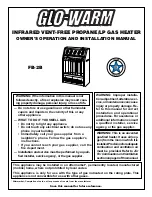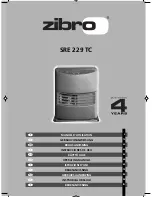
SALZBURG
Installation and Operation Manual
solid fuel heater with baking oven
SALZBURG, SALZBURG II and SALZBURG III
tested according to the standard EN 13240
1. Installation Instruction
The heater has been designed to allow simple connection to an existing chimney by a single connecting piece. The connecting piece
must be as short and straight as possible, in a horizontal position or slightly inclined. The piece must be tight.
Be sure that all local regulations, including those concerning both national and European standards on construction and fire prevention,
are respected during installation. Inform the competent inspector prior to installation. Be sure that combustion air supply is sufficient;
particularly in rooms where windows and doors are closed tight.
Chimney properties shall be calculated in accordance with STN 73 4201 and STN 73 4210 with the three values stated in this manual.
The heater must stand on a hearth with adequate bearing capacity. If bearing capacity is too low, adequate measures must be taken
(e.g. a board must be laid to split weight).
2. General Safety Instructions
Fuel combustion emits calorific energy that heats the surface of the heater, combustion chamber door, door and control elements
handles, safety glass, flue pipes, and eventually also the front of the heater. Do never touch those parts without adequate safety wear
or elements (fireproof gloves etc.).
Warn children of such danger and make sure they do not stay close to heater when in operation.
3. Acceptable Fuel
Fuels acceptable for burning include wood logs of up to 25 cm in length and 30 cm in circumference, and lignite briquettes.
Make sure that only air dried wood logs are used. Burning of waste, and plastics in particular, is forbidden by law on emissions.
Besides, such fuel may cause damage to the fire place and chimney and subsequently may injure health and smell may annoy your
neighbours. Air dried wood logs with 20% maximum humidity may be obtained after at least one year (soft wood) or two years (hard
wood) of drying.
Wood is not slow combustion fuel and thus, continuous heating throughout the night is not possible when burning wood.
Liquid fuel is unacceptable.
4. Firing
During the first firing bad smell due to drying of protection paint is inevitable but the smell shall fade quickly. Make sure the room with
the heater is well aerated when firing. Quick firing is essential because incorrect procedure may cause increased emissions.
Add more fuel as soon as firing fuel catches fire. Do never use alcohol, petrol or other flammable liquids for firing. Do always use some
paper, wood chips, and a small amount of fuel for that. Make sure that primary and secondary air is supplied to heater when firing.
Make sure that heater is under control during firing.
5. Operating More than One Fireplace
Make sure that combustion air supply is sufficient when operating more than one fireplace in one room or within the same air system.
6. Transition Season Operation
When exterior temperature rise during transition season draught can decrease at low burning capacity and flue gas may not be
evacuated completely. In such case add only small quantities of fuel and open the slider of primary air supply so that loaded fuel burns
more quickly (flame) and draught gets steady. Ash needs to be raked carefully more often to enhance air circulation below fireplace.
7. Cleaning and Checking
Heater flue pipes need to be checked for deposit and eventually swept at least once a year or more often, e.g. while sweeping chimney.
Make sure your chimney is swept regularly by a chimneysweep. The frequency of sweeping shall be defined by competent inspector.
Heater should be checked by an expert every year.
8. Versions
Heaters with spring fireplace door can be connected to a chimney with multiple taking for other heaters and fireplaces provided that
dimensions of the chimney are in compliance with STN 73 4201 and STN 73 4210.
The door of the heater with spring fireplace door must always be closed during operation, except for firing, fuel charging, and ash
removing. Otherwise operation of other equipments connected to the chimney may be affected or flue gas may leak.
9. Combustion Air
Since heaters are fireplaces depending on surrounding air and take combustion air from the room, adequate intake of combustion air is
vital.
EN


































